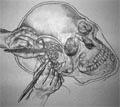The eLitMed.hu medical portal uses computer cookies for convenient operation. Detailed information can be found in the Cookie-policy.
Clinical Neuroscience - 2009;62(01-02)
Content
[Pain sensitivity changes in schizophrenic patients and animal models. Part I.]
[Diminished pain sensitivity in schizophrenic patients has been reported for more than 50 years, however little is known about the substrate and the basic mechanisms underlying altered pain sensitivity in this disease, therefore, relevant animal models are of decisive importance in the study of psychiatric diseases. The authors report a review consisting of two parts focusing on pain sensitivity changes in patients and in different animal models, which proved the eligibility as schizophrenia models and pain sensitivities have also been determined. The first session discusses the pain sensitivity changes in patients and chronic animal models induced by chronic drug treatments, social isolation or cerebral lesions. The results of human studies suggest that hypoalgesia in schizophrenia might be the endophenotype of this disease, however further studies are warranted to determine the clinical and biological correlation and the social and health consequences of hypoalgesia in schizophrenia. The animal data indicate that the pain sensitivity has changed in most models; however, there are significant controversies between the results, therefore, further studies are needed to find the ideal model.]
[Conductive education for children with neurological diseases]
[Conductive education, developed by the 40-s last century, spread out in the world in spite the lack of hard scientific evidences for its benefit. There are sorts of cerebral palsies (athetosis, ataxia) in which conductive education might have the unique role to help. In cerebral palsies of other sorts it is much helpful if the disturbance of body scheme and degree of somatomotor neglect are superior to the palsy. Short term results of conductive education are to see in the better movement coordination whilst the long term outcome is the increased activities of daily living.]
[Neuroprotection in Parkinson’s disease and other neurodegenerative disorders: preclinical and clinical findings]
[The authors summarized the evidence supporting neuroprotection based on the data available in the literature. In vivo and in vitro studies have indicated that many compounds can decrease neurodegeneration, excitotoxicity, oxidative stress, protein aggregation, disturbance of Ca2+ homeostasis and compensate the energy impairment. Selegiline, rasagiline, dopamine agonists and other molecules (ubiquinone, kynurenic acid, tocopherol, creatine, glatiramer acetate) exert neuroprotective effects in preclinical studies. Much less clinical data are available regarding neuroprotection in different neurological disorders. In this review, such preclinical and clinical evidences are summarized.]
[Measurement of mental fatigability by task related spectral EEG. A pilot study (in English language)]
[Background - Task related EEG spectra are promising markers of mental activity. But the cooperation of the patients necessary for the registration limits its application in the neuro-psychiatry. Methods - EEG difference spectra on counting (EDSC) - was developed to detect the effect of a short calculation task on the spectral EEG. The originality of the task situation is a continuous mental work in a very short period of time, while the level of task difficulty is adapted to the patient’s actual mental capacity. While the rest pre-task and the post task EEG sections were compared, the results show the mental “EEG fatigability” caused by the short intensive cognitive activity. The first preliminary results have been demonstrated by a comparative study of two healthy and three patient (probable Alzheimer disease, post-stroke state without mental deficit and mixed type of dementia) groups. Results - Similarly to the findings of other authors, in addition to the differences of the alpha band seen on the temporo-parieto-occipital regions, the frontal localization and the beta band seem to be prominent, too. Demented patients had stronger EEG reactions than post-stroke patients without mental deficits and healthy elder persons had more extensive changes than the younger ones. Conclusions - The test can be considered as indirect marker showing the different mental fatigability in diverse pathological conditions and during the aging process. Effect of therapeutic processes can also be followed based on “key-lock principle”. Standardization of the test is essential for the introduction of EDSC to the every-day routine of clinical neuropsychiatry.]
[Genetically determined neuromuscular disorders of some roma families living in Hungary (in English language)]
[The authors discuss the clinical and molecular genetic aspects of genetically determined neuromuscular disorders of some Roma families living in Hungary. Among the autosomal recessively inherited spinal muscular atrophic (SMA) group, 8 Caucasian children had the typical 7-8 exonal deletions of the SMA gene, but only 2 patients belonged to the Roma population. There was no difference in the molecular genetic findings among the Caucasian and the Roma SMA patients. All of them had 7- 8 exonal deletions of the SMA gene. We wanted to call attention to the founder mutation of the Roma population in 7 patients suffering from congenital myasthenia (CMS) from 3 Roma families. The 1267G deletion for CMS was detected by molecular genetic method. Clinical onset was pubertal and relatively slow progression of specific and phenotypic features for this founder mutation of acetyl-cholin receptor epsylon gene. In 2 patients (sister and brother) the sarcoglycanopathy 2C type C283Q mutation was proven in one Roma family suffering from limb-girdle muscular dystrophy (LGMD). Two out of the three facioscapular-humeral dystrophy (FSHD) Roma families carried 21.8 kb and 18.5 kb alleles in FSHD A1 gene (D4S139). In one family together with prenatal diagnosis founder mutation in FSHD A1 gene was detected, according to the autosomal dominant (AD) inheritence. In (F2) prenatal diagnosis was carried out, 18.5 kb/18.5 kb homozygosity was proven in the fetus, so the pregnancy was interrupted. In the CMS, LGMD and FSHD Roma patients ancient typical Roma founder mutations were found.]
[Application of robot hand technique in the course of microneurosurgical operations]
[Introduction - The aim of this study was to determine whether the new robot hand technique can help to avoid the complication in the course of high precise microneurosurgical operations. Methods - The physical efficacy was measured by tremorometry. The comperative study of the incidence of complications measured the clinical efficacy. Results - The tremors of the operating hand and the number of complications have decreased effectively. Conclusion - The precise level of robots could be available by novel robot hand technique. By this technique the microsurgical work has become more effective.]
[Account on the scientific meeting of the Környey Society in 2008]
[Account on the scientific meeting of the Környey Society in 2008 2009;62(01-02)]
1.
Clinical Neuroscience
[Headache registry in Szeged: Experiences regarding to migraine patients]2.
Clinical Neuroscience
[The new target population of stroke awareness campaign: Kindergarten students ]3.
Clinical Neuroscience
Is there any difference in mortality rates of atrial fibrillation detected before or after ischemic stroke?4.
Clinical Neuroscience
Factors influencing the level of stigma in Parkinson’s disease in western Turkey5.
Clinical Neuroscience
[The effects of demographic and clinical factors on the severity of poststroke aphasia]1.
2.
3.
4.
5.









